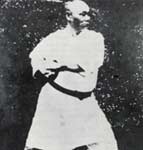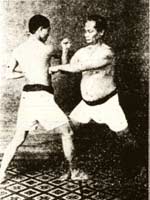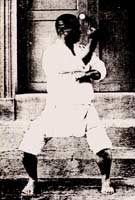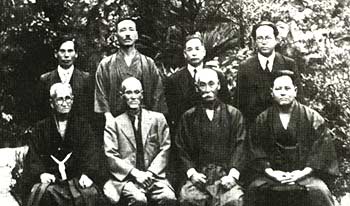Choki Motobu:
Through The Myth ...To the Man
Part 2
By Tom Ross
 Editor's
Note: This is the second of a two articles exploring the truths
and misconceptions about Choki Motobu who was arguably one of Okinawa's
greatest early twentieth century karate masters. Part
one discussed Motobu's childhood, family, education and
early karate training. Part two discusses the kata Motobu knew and practiced,
his move to Japan, rivalry with Funakoshi, accomplishments and his continuing
legacy.
Editor's
Note: This is the second of a two articles exploring the truths
and misconceptions about Choki Motobu who was arguably one of Okinawa's
greatest early twentieth century karate masters. Part
one discussed Motobu's childhood, family, education and
early karate training. Part two discusses the kata Motobu knew and practiced,
his move to Japan, rivalry with Funakoshi, accomplishments and his continuing
legacy.
The Kata Of Motobu
Although it is often alleged that Motobu knew only the katas Naihanchi
Shodan and possibly Passai, in light of recent developments this appears
to be a complete misinterpretation of Motobu's knowledge and method
of teaching. It was quite a common practice in the old days to begin
a student training with Naihanchi kata and only when he mastered it
to a degree considered sufficient was a new form taught. This seems
to be corroborated through the words of Konishi Yasuhiro (as told by
Yamazaki Kiyoshi in an article on Konishi) (4):
"Konishi Sensei considered Motobu to be a martial
genius and made every effort to train with him. Motobu Sensei's favorite
Kata was the Naifanchin kata (another pronunciation of Niahanchi).
As a teacher he knew many Kata, but would only teach them once the
student had mastered Naifanchin."
Given Motobu's vast knowledge of Naihanchi, the applications of which
were forged through actual altercations, it likely took a significant
period of time to progress to another kata with him. Thus many of the
modern stories which recount Motobu as knowing or having shown only
the kata Naihanchi are told by those having trained for less than a
year with him!
Further proof of Motobu's knowledge of other Kata comes inadvertently
from Motobu himself. Motobu is quoted by Nakasone Genwa as describing
a visit to Itosu Sensei (Itosu was perhaps the most famous karate teacher
of his time) as follows:
"I visited him one day near the school, where
we sat talking about the martial arts and current affairs. While I
was there two to three students dropped by and sat talking with us.
Itosu Sensei turned to the students and said 'Show us a kata!' The
Kata they performed was very familiar to the Channan Kata that I knew
but there were also some differences. Upon asking the students what
the kata was, he replied, 'It is Pinan no Kata!'. The students left
shortly after that, upon which I turned to Itosu Sensei and said 'I
learned a Kata called Channan, but the Kata that those students just
performed now was different, What is going on?" Itosu Sensei
replied, "Yes, The kata is slightly different but the kata that
you just saw is the kata that I have decided upon." (Nakasone
1934)
While it has been speculated that Motobu never learned the Pinan kata
(sometimes known as Heian), it appears now that this information may
be correct. Motobu learned from Itosu before Itosu had fully developed
the Pinans, a time when the katas were still practiced in their prototype
form.
We further know that Choki Motobu passed on a significant array of
kata which are part of the curriculum as maintained by his son Chosei.
They include Naihanchi Shodan and Nidan, Channan (the predecessor of
the pinan kata which within the Motobu system are called Shiraguma no
Kata), Passai, Wanshu, Wankan, Chinto, Kusanku, Chinti and others. This
demonstrates that Motobu was far more knowledgeable in terms of the
kata than many have given him credit for.
Move To Japan
In 1923 (Iwai 1994; other sources say 1921), perhaps in an effort to
find greener pastures, Motobu moved with his family to the city of Osaka
on mainland Japan. Not long afterwards he returned briefly to Okinawa
for three months which he spent training with his brother Choyu. This
was when a nineteen year old student of Choyu by the name of Seikichi
Uehara first met Choki. Uehara recalled having Choki for a training
partner: "Every time I punched Choki hit my arm before I could
touch him. He hit it so hard he almost broke my arm" (Uehara 1992).
Soon after Choki returned to Osaka, he obtained a job as a security
guard. This was no small feat for someone who reputedly never learned
to speak Japanese in any fluent fashion. We must remember, however,
that Motobu was nobility by birth and perhaps as an act of personal
defiance (which was not unheard of in those days, something also done
by the karate legend Hohan Soken), he refused to humble himself and
learn what was to him a foreign tongue.
In November of 1924 (Iwai 1994) an event would took place which brought
Choki to the attention of many on mainland Japan. On his day off from
work at the factory, Choki and his landlord saw a sign advertising a
challenge match with boxers in Kyoto and decided to go. Having viewed
several matches where the boxer (reputed to be a European boxing champion)
defeated several judo people, Motobu accepted the challenge himself.
He entered and felled the much larger boxer.
Motobu would later recount to students: "When I fought the foreign
boxer in Kyoto, he was taller than me so I jumped up and punched him
in the face. This is effective against people who are taller than you."
(5) This did much to stimulate Motobu's
reputation (according to Iwai) and many began to seek him out for instruction.
Another source (Choso Nakama quoted in the book, "Okinawa Karate"
by Mark Bishop) recounted that Motobu had at first just dodged the boxer.
But in the second round the boxer came on strong. Motobu hit him (after
jumping up) with a typical "Ti" (old term for karate) technique,
a knuckle strike behind the ear.
At fifty-two years of age and after putting his honor and reputation
on the line, Choki finally began to attract the attention he truly deserved.
Choki formed the Society for the Promotion of Toudijutsu (an old term
for karate).
It certainly must have been a shock to Motobu, however, when in the
following September (1925) an article appeared in Kingu magazine describing
his bout with the boxer.
| |
| |
1925 King Magazine article showing Funakoshi,
not Motobu, defeating a boxer in a challenge match.
|
The picture accompanying the article, however, was not of him. Instead
it was a drawing of none other than Gichen Funakoshi, shown as felling
the boxer.
It was rumored by those close to Motobu that he was angry about this
misrepresentation but felt quite helpless against the resources of company
the size of Kodansha (which owned Kingu). Perhaps he felt Funakoshi
himself or one of his collage student Karateka (where many journalists
began) was behind the error.
In any event there was certainly some bad blood between them and this
incident may very well have played a part in Motobu's decision to go
to Tokyo and seek out Funakoshi.
Although many stories exist about a confrontation between the two (6),
I am unable to find any confirmed accounts giving specifics of the battle.
David Chambers, however, in a Tsunami video tape, "Wado Ryu the
way of peace and harmony," claims that: "Yasuhiro Koneshi
reported that a newspaper carried the story of a fight that took place
between the two in 1930. When Funakoshi finally faced his nemesis, his
feet were instantly swept from beneath him and he suffered the indignity
as he lay at Motobu's feet of having his face menaced with the latters
enormous fist."
Whatever the facts of this story, Motobu was beginning to attract attention.
Several judoka and wrestlers sought him out to learn fighting skills.
Two of Funakoshi's top students (Hironori Ohtsuka and Koyu Konishi)
also left to train with Motobu. The defection further added to the deterioration
of relations between the two teachers. Another karateka to seek out
Motobu was Kose Kuniba (known as Kosei Kokuba in Okinawa).
Interest in the testing of karate fighting skills was perhaps understandable
since in Japan at that time, judo (a synthesis of old jujutsu self-defense
systems) and kendo (old warrior sword arts modified into a sporting
form) had been adopted into the Japanese education curriculum and were
popular. Both offered competition formats. The attraction of practice
fighting thus naturally bled over to many young karateka who sought
to test their skills or develop effective technique in their own art.
The true feelings between Motobu and Funakoshi may never truly be known.
But, it can be assumed that Funakoshi (a well educated school teacher
who spoke Japanese and was well versed in Japanese social customs) may
have regarded Motobu to be densely illiterate. He was also probably
irritated by the fact that Motobu was higher placed in the old Okinawan
class system. Motobu in turn probably regarded Funakoshi as a mere confidence
man, someone who had learned only the most superficial aspects of karate
and kata and was not a strong fighter.
If Motobu's intent in traveling to Tokyo was to drive Funakoshi out,
he didn't succeed. Funakoshi had been there a bit too long and Motobu's
lack of linguistic ability surely limited his ability to communicate.
To Motobu's credit he did manage to author two rather excellent books
on Karate. It has been put forth by Chozo Nakama (a disciple of Chosin
Chibana) that these works were dictated and translated into proper Japanese
for publishing. This is only logical since Motobu didn't speak more
than pigeon Japanese.
The first book, "Okinawa Kempo: Karate-Jutsu On Kumite" was
published in 1926. It came just four years after Funakoshi produced
the first published book on karate. Funakoshi's book (1922 and updated
with photos instead of drawings in 1924) illustrated mostly kata and
formalized self-defense. The two books couldn't have been more different.
Funaksohi's book reflected his own personal preference of kata as a
principal teaching method and his opposition to focusing on sparring.
He considered it detrimental to karate practiced as a martial way.
 |
Motobu's book was just to opposite.
Its focus was on fighting -- effective close-in skills as illustrated
in this photo. Featured were a series of practical responses to
variety of attacks. Utilized were a variety of punches, vital
point and unbalancing techniques accompanied by grabs, blocks,
knees and strikes using both arms. Kicks, it should be noted,
were minimal. |
| In 1932 Motobu published a second
book, "Watashi no Karatejutsu" ("My karatejutsu")
which served as a natural complement to his first. This book focused
on illustrating his favorite kata, Naihanchi, along with many
applications, some of which had been adopted and illustrated in
his first book. Notice that this photograph from his book illustrating
a move from the kata Naihanchi (Tekki in some Japanese systems)
illustrates the same stance and technique as used in a fighting
technique (above photo) illustrated in his first book. |
 |
Coming Home
Choki Motobu returned to Okinawa several times, most notably for the
1936 meeting of the masters sponsored by the Ryukyu Shinposha (Okinawa
newspaper company). The purpose of this meeting was to discuss the promotion
and future development of Karate (McCarthy 1994).

Other attendees included such other karate masters as Chojun Miyagi,
Choshin Chibana, Chomo Hanshiro, Shinpan Gusukuma, Juhatsu Kiyoda and
Chotoku Kyan. (7)
Motobu was respected both as a person and a martial artist during his
lifetime. After his death, however, negative rumors and stories circulated
(perhaps propagated by those who feared him in life). He is often described
by those who actually knew him, however, as a quiet man who presented
the very picture of dignity.
Choki Motobu passed from this life on August 1944.
Concepts of Toudi (karate)
The following are but a few of the noted concepts Choki Motobu expressed
to his students and are recorded by Hashihiko Nakata as overseen by
Kenji Marukawa (a direct student of Choki Motobu) from the 1978 essay
"Motobu Choki Sensei Goroku" (Collection of sayings by Choki
Motobu) as partially translated by Joe Swift.
"Everything is natural and changing.
Kamae is in the heart, not a physical manifestation.
One must develop the ability to deflect attack even
from behind.
In a real confrontation, more than anything else
strike to the face first, as this is most effective.
When punching to the face one must thrust as if punching
through the head.
Kicks are not all that effective in a real confrontation.
When blocking kicks, one must block as if trying
to break the opponents shin.
One must try and block the attack at its source (Block
not the attacking hand but deeper on the arm).
Karate IS Sente
One can not use continuous attacks against true Karate.
That is because the blocks of Karate make it impossible to launch
a second attack."
Motobu's Legacy
While Motobu never became as famous as Funakoshi, around whom Shotokan
karate and its many offshoots developed, he did leave a rich karate
heritage in the Osaka, Kyoto and Gunma areas of Japan. While he never
organized his own system, he did play a positive role in the development
of several karateka who went on to become famous in their own right.
This included Yasuhiro Konishi (who also studied with Funakoshi) who
founded Shindo Jinen Ryu in 1934 and Kose Kuniba who founded Seishinkai
Karatedo in 1934. Another student was Hironori Ohtsuka (also a well
known student of Funakoshi) who went on to found Wado-ryu karate with
a curriculum that stressed practice fighting, something that reflected
Motobu's influence.
Choki Motobu's son, Chosei, also continues to teach his father's tradition
of karate. The style is known as Nihon Denryu Heiho Motobu Kempo and
the name of his individual dojo is the "Daidokan."
Between the publication of his second book and his return to Okinawa
in 1936, there is little information, but there is one fascinating reference.
It is recorded that he traveled to Hawaii in March of 1932 and encountered
visa problems.
Refused entry, for about a month he was detained at Honolulu immigration
station before being returned to Japan.
While in Hawaii Motobu began to instruct Thomas Shigeru Miyashiro,
a resident who tried to help Motobu with his visa problems. This started
a continuing relationship with Motobu, who is reported to have asked
both Mizuho Mutsu and Kamesuke Higashionna to continue to help train
Miyashiro when they traveled to the island the next year. This relationship
was later continued by Choki's son. Chosei (along with Takeji Inaba)
visited Hawaii Karate Seinenkai on April 25, 2001.
It is my sincere hope that in the future additional facts will come
to light about this great man and that he will be given credit not only
as a talented Karateka but as the Martial Genius I believe he truly
was. It will only be through the objective observation of the facts
and accounts of those who knew Choki Motobu that we will be able to
see "Through the Myth to the Man."
Acknowledgments
Special Thanks to Joe Swift for his friendship, encouragement and translations
as well as his intense dedication to Karate which allowed me to obtain
the substance to back my thoughts and without whom this search for the
truth would not have been possible. Thanks also to Christopher Caile
whose editing, addition of pertinent historical facts and historical
photo collection added much to this article series. Thanks also to Patrick
McCarthy for the images from the 1925 King Magazine article which depicted
Funakoshi, not Motobu, defeating a boxer in a challenge match and the
picture of Motobu's 1932 book, "Watashi no Karatejutsu," which
he is currently translating.
Footnotes
(1-3) Footnotes found in part
one of this two part series.
(4) As recounted in a special article for Dragon
times Vol. 9, The Origins of Karate-do, "Shindo Jinen Ryu Karate,"
Yasuhiro Konishi Sensei's contribution to Karate by Howard High (Note:
The Dragon Times in its printed version of its publication erroneously
attributed the authorship of this article to Kiyoshi Yamazaki, an error
corrected in the Web version of the article).
(5) As noted in the text Motobu Choki Sensei: Goroku" by
Hashihiko Nakata 1978.
(6) In Nakata's 1978 book, which was overseen
by Choki's direct student Kenji Marukawa, Motobu recounts the following
statement: "When I came to Tokyo, there was another Okinawan there
who was teaching Karate quite actively. When in Okinawa I hadn't even
heard his name. Upon guidance of another Okinawan I went to the place
where he was teaching youngsters, where he was running his mouth, bragging.
Upon seeing this, I grabbed his hand, took up the position of Kake kumite
and said "What will you do?" He was hesitant, and I thought
to punch him would be too much ' so I threw him with Kote Gaeshi at
which he fell to the ground with a thud. He got up, his face red and
said "Once more" so we took up the position of Kake Kumite
again, and again I threw him with Kote Gaeshi. He did not relent and
asked
for another bout, so he was thrown again for a third time."
(7) It was at this meeting that the masters
agreed to the change of the first character ("Kara") in the
name karate to mean "empty," rather than "Chinese"
(both characters are pronounced the same) which had been the most widely
used meaning up to that time. This was an important change because "empty
hand" was a much more acceptable meaning of the term karate in
Japan than "Chinese hand. This change was an important factor in
the widespread adoption of karate on the Japanese mainland.
References
Koden Ryukyu Karatejutsu (Tokyo Airyudo 1994) by Iwai
Tsukuo (partial translation by Joe Swift)
"Channan: The 'Lost' Kata of Itosu?" (Insights
into the Martial Arts, NZ, in press) by Joe Swift. Also an article featured
by FightingArts.com.
"Unante The Secrets of Karate," by John Sells
(1996)
Motobu Choki Sensei Goroku (Collection of sayings by
Choki Motobu) by Nakata Hashihiko, overseen by Marukawa Kenji 1978 (partial
translation by Joe Swift)
Tales of the great Okinawan Masters by Shoshin Nagamine
(Translation by Patrick McCarthy)
The minutes of the 1936 meeting of the masters as translated
by Patrick McCarthy 1994 and found in "The Ancient Okinawan Martial
Arts: Koryu Uchinadi 2," by Patrick McCarthy
Bu No Mai : Ryukyu Oke hiden Bujutsu: Motobu ryu Udundi
(Dance of the Martial arts: The secretly taught arts of the Okinawan
Kings family:Motobu-ryu Udundi) by Uehara Seikichi (October 1, 1992)
Tokyo: BAB, Japan Printing bureau
About The Author:
Tom Ross is a retired NYC Correction Officer who specialized in the
Handling of Security Risk group prisoners. A Yudansha in Shorinjiryu
Kenzenkai Karatedo (an Offshoot of the Shorinjiryu Kenkokan founded
by Masayoshi Hisataka), he also spent six years studying Jujutsu (classical,
modern and Brazilian). Possessing an avid interest in the history
of martial arts and traditions he currently serves as the Research
Coordinator for FightingArts.com as well as moderating its Martial
Arts Talk forum. He additionally serves as the moderator of the Sabaki
List (which is dedicated to various martial artists and full contact
stylists) and is a member of the International Hoplology Society.